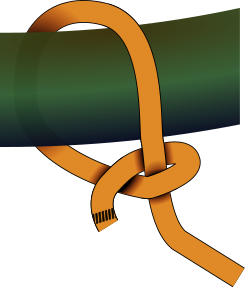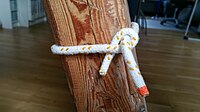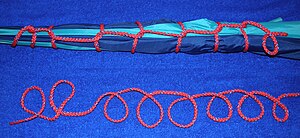Half blow
| Half blow | |
|---|---|

|
|
| Type | Basic form |
| application | Attaching the rope |
| Ashley No. | 48, 49, 50, 1662, 1026, 1717, 1780 |
| English | Half hitch |
| List of nodes | |
A half hitch or half stitch is a basic form in the knots . It arises when the loose part is used to make a simple turn around its own standing part .
In knot science
As a basic form, half a beat is part of many knots, such as B. the round trip with two half strokes . It can also be used to secure a free end of the rope.
Loom line secured with two half-folds
Demarcation
If you put a simple trip around another object and not around your own standing part, it is only called a beat or a single beat . However, this strict distinction is often not made. Most of the time, both forms are used as half beats.
For the demarcation of the half knot from the overhand knot and half knot, see: Overhand knot .
application
fire Department
The fire services put a punch around beams or other long objects that have to be pulled up or lowered in order to be able to guide them better and to prevent them from knocking around uncontrollably. As a rule, it is used together with a mast throw or a double sling , which are used to actually attach the device.
Even when coupling a suction line together , a half- stroke ( single stroke , see delimitation ) is attached to each individual suction hose . This is easier to handle with the line attached to the suction line with half-blows.
Building trade
On the building site and by carpenters, beams are fastened at the bottom with the carpenter's knot, and secured at the top with a half knot ( single knot , see demarcation ), and can thus be pulled up vertically with a rope.
sailing
A line can also have a half-turn on the winch . For this purpose, the loose end is pulled through under the fixed end as a bay and this is slipped over the winch as a half blow. A kind of “ stopper link ” then arises . The same goes for an anchor chain on the chain bollard.
With the mainsheet or an auxiliary line the aufgetuchte can sail on the boom be lashed. To do this, you tie several half-loops around the sail and tree. Half strokes can be used to fasten a sail to a spar . The Marlschlag is preferable, however. It is used to attach Schmarting to the standing rig. The Marlschlag is preferable to the Half Beat because the Kleeden lies smoother over it .
modification
If you tame the loose end, you get a stopped or ghosted half blow . This is very safe (ABoK 1026)
Individual evidence
- ↑ a b c d Clifford W. Ashley: The Ashley Book of Knots. Over 3800 knots. How they look like. What they are used for. How they are made. 6th edition. Edition Maritim, Hamburg 2005, p. 528 (# 3114)
- ↑ Clifford W. Ashley: The Ashley Book of Knots. Over 3800 knots. How they look like. What they are used for. How they are made. 6th edition. Edition Maritim, Hamburg 2005, pp. 24, 25 (# 54)
- ↑ Clifford W. Ashley: The Ashley Book of Knots. Over 3800 knots. How they look like. What they are used for. How they are made. 6th edition. Edition Maritim, Hamburg 2005, p. 24
- ^ A b Clifford W. Ashley: The Ashley Book of Knots. Over 3800 knots. How they look like. What they are used for. How they are made. 6th edition. Edition Maritim, Hamburg 2005, p. 528 (# 3115)













